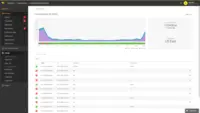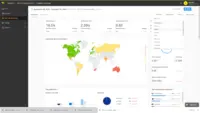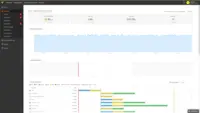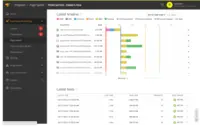Overview
What is SolarWinds Pingdom?
SolarWinds Pingdom is a website uptime monitoring and alert tool, with additional reporting and Real User Monitoring capabilities. Pingdom is part of SolarWinds’s DevOps package, enabling full-stack monitoring as a service.
SolarWInds Pingdom - poorly maintained and poorly supported
Cost-effective uptime monitoring
We have several …
Great for Monitoring
Pingdom: From Royalty to SolarWind Level Performance
Well suited product meeting the expectations
Simple and easy to use
Pingdom = peace of mind
Reliable All-in-One Website Monitoring Tool
SolarWinds Pingdom is a feature driven, stable application monitoring platform
Happy user for monitoring and alarms
Nice tool required to run a business smoothly
Pingdom an easy to implement, mandatory no brainer for your org.
Versatile
Excellent monitoring tool
Experience with Pingdom
Awards
Products that are considered exceptional by their customers based on a variety of criteria win TrustRadius awards. Learn more about the types of TrustRadius awards to make the best purchase decision. More about TrustRadius Awards
Reviewer Pros & Cons
Pricing
Synthetic Monitoring
$10
Real User Monitoring
$10
Enterprise
Custom Pricing
Entry-level set up fee?
- No setup fee
Offerings
- Free Trial
- Free/Freemium Version
- Premium Consulting/Integration Services
Starting price (does not include set up fee)
- $14.95 per month
Product Details
- About
- Integrations
- Competitors
- Tech Details
- Downloadables
- FAQs
What is SolarWinds Pingdom?
SolarWinds® Pingdom® is a SaaS-based web app performance monitoring solution. It provides web app performance and user experience monitoring consisting of four major capabilities:
- Uptime monitoring for webpages and other critical components like APIs, CDNs, DNS, networks, email, and more
- Page speed performance monitoring and page rankings
- Synthetic transaction monitoring from the simplest to the most complex transactions
- Real user monitoring (RUM), enabling a deeper and wider understanding of the user’s digital experience, and web application availability and performance
SolarWinds Pingdom Features
- Supported: Uptime Monitoring
- Supported: Synthetic Transaction Checks
- Supported: Page Speed Tests
- Supported: Real User Monitoring (RUM)
- Supported: No-Code Transaction Recorder
- Supported: Dashboards & Reporting
- Supported: Over 100 Probes Worldwide
- Supported: Developer-Friendly API
- Supported: Alerts & Notifications
SolarWinds Pingdom Screenshots
SolarWinds Pingdom Video
SolarWinds Pingdom Integrations
SolarWinds Pingdom Competitors
SolarWinds Pingdom Technical Details
| Deployment Types | Software as a Service (SaaS), Cloud, or Web-Based |
|---|---|
| Operating Systems | Unspecified |
| Mobile Application | No |
SolarWinds Pingdom Downloadables
Frequently Asked Questions
Comparisons
Compare with
Reviews and Ratings
(121)Community Insights
- Business Problems Solved
- Recommendations
Pingdom is a versatile tool that users rely on to monitor the uptime of their websites and ensure they are up and operational. With Pingdom's notifications via Mobile, Email, and Slack Integration, users can quickly resolve any downtime issues and avoid potential revenue loss. The tool is widely used by multiple departments within organizations for front-line monitoring of core public-facing services, allowing them to be proactive and react as soon as they receive a notification of downtime, preventing further issues. Additionally, Pingdom is used for uptime monitoring and verification of responses from specific endpoints, which assists in diagnosing issues. Its ability to support different monitoring types makes it a preferred choice for many users.
Furthermore, Pingdom serves as an uptime monitor for cloud applications, providing direct notifications and general uptime statistics. Users rely on Pingdom to monitor URL/endpoints and website uptime, ensuring optimal performance. It also helps in managing preventive failures and troubleshooting during scheduled maintenances. Additionally, Pingdom allows for the addition of notification-only users, facilitating collaboration with other teams. As a service provider, Pingdom is a primary tool for monitoring uptime for clients. Users appreciate its simplicity and ease of setup and maintenance. Integration with OpsGenie allows for quick resolution of alerts and efficient management of downtime. Overall, Pingdom is a helpful tool for monitoring and testing websites, analyzing page speed, overall performance, compliance with SLAs, and providing reliable customer service.
Users have made several recommendations based on their experiences with Pingdom. The most common recommendations are as follows:
- Users recommend allowing ICMP traffic and configuring the alerting system properly to avoid excessive alerts in Pingdom.
- They also suggest using Google Chrome Developer Tools to gain a better understanding of visitor experience with different network speeds.
- Additionally, users highly recommend considering the free plan offered by Pingdom for basic uptime checking.
Overall, these recommendations highlight the technical reliability of Pingdom as a monitoring platform and provide suggestions on optimizing website performance and monitoring experience.
Attribute Ratings
Reviews
(1-25 of 33)- Very Inexpensive
- Easy to use
- SSO built in
- MFA Built In
- ZERO Product Updates since October 2021
- Last SOC 2 certification April 2022 had several key findings identifying management and operational failures
- Support is HORRENDOUS. No responses for weeks at a time.
- No reported changes or outages in the last year
Happy user for monitoring and alarms
- Downtime Alarms through multiple channels to multiple team members
- Uptime monitoring, with easy to understand metrics (for C-Level analysis)
- SLA reports
- I was not a direct user of the tool, but as a decision maker I didn't receive any negative feedback from the team.
Pingdom an easy to implement, mandatory no brainer for your org.
- Ping latency from around the globe or region specific
- Real time user simulations allowing deep analysis of performance and experience
- Integrates wonderfully with the rest of the Solarwinds Platform to provide incredibly detailed transaction logs from end to end.
- Integration of pingdom into Solarwinds platform is prone to disruptive changes where existing api templates are replaced without retaining function.
- Integration of payment is still prone to issues given pingdom prefers credit card payment vs standard invoice approach used by enterprise orgs. 3rd year of repeated issues due to this during renewal.
Even if you don't have public facing portals and sites that customers need to utilize it can still provide immense benefit to external connection points for vpn, or citrix/horizon portals used by employees.
Experience with Pingdom
- Multi global monitoring edges
- Page speed and performance reports
- Tags to customize uptime dashboard
- Transactions monitoring
- Real user monitoring
- Public status page
- Edit check
- Transaction monitoring
- Performance report
Pingdom gave us a great insight into our website outages
It was a bit of an eye-opener, as it turns out our website was going down a lot more often than we were aware. By comparing the Pingdom alerts to our firewall and webserver logs, we were able to track down the cause of our issue.
- Instant alerts
- Weekly reports
- Alerts when device is back online
- Testing of individual webpages
- Handling other types of webpage e.g. a *.esp page
- Ability to add users directly, rather than via my.solarwinds.cloud
- Sending of additional details when a device is down e.g. a screenshot of the webpage error
It's less appropriate for monitoring IPs on your LAN, unless you NAT these through your firewall.
10+ Year User of Pingdom - Why I Love It!
- Easy to use
- Cost effective
- Never fails us (or hasn't yet)
- Nothing at this time
Pingdom does what it says on the tin..!
- The alerts are very responsive offering quite detailed timing information
- The UI for reports is very clear and set up of reports is very intuitive
- Customer service was good when there were problems - e.g. lapsing billing causing reporting to go down
- There could be more information about how to get the most out of the pingdom product(s) - we have a very defined use case but ultimately not entirely sure what else we can do with our subscription
- Not sure whether you can use Pingdom for multiple clients.
- The account management system is quite confusing - trying to access account information about the Pingdom product specifically was difficult as it redirected to a general solarwinds account platform
SolarWinds Pingdom, Keeping you on track
- Customized alerts
- Server monitoring
- Hardware Health
- Alerting on Network issue
- Online support Forum
- More modern interface
Pingdom - Great Value and does just what you need
- Ease of use
- Value for money
- Reporting
- Inability to capture Real User Monitoring stats for searches within a page
Pingdom as monitoring tool
- Monitoring of application availability.
- Monitoring of application disk space, CPU usage.
- Integration with other tools like OpsGenie.
- It is sometimes slow to generate alerts when events happen.
- It monitors on limited metrics.
- It is costly for small enterprises.
Excellent monitoring and health-check service
- Monitor the availability of servers / services
- Monitor the uptime of servers / services
- Monitor the response time of servers / services
- I have nothing in mind to say about areas that needs to be improved in this service
Excellent Monitoring Solution
- Uninterrupted monitoring
- Faster and smarter alerts
- Downtime reports
- Easier coding for transcript checks
- Bulk modification of checks
- Mobile app
SolarWinds Pingdom - Does What It Says!
- Alerting
- Monitoring
- Uptime reporting
- Updating alerting settings
Happy with Pingdom + PagerDuty for uptime monitoring
- Alerting, particularly the integration with PagerDuty.
- Reporting: the ability to go back and view the history of each status check (including details about every failure) as well as graphs and reports over a longer time period.
- Weekly uptime report emails are very convenient.
- Programmatic configuration is possible with a third-party Terraform plugin.
- The PagerDuty integration could be a lot better. When you use the PagerDuty integration, it doesn't send any information about which check failed! It just sends a message like "Timeout (> 30s)" -- this isn't very helpful when we have hundreds of checks. We've worked around this by using both the PagerDuty and Slack integrations and having them both post to the same Slack channel. But this means that when an engineer is paged from PagerDuty, they have to go to Slack (or Pingdom) to find the details about the page; it's not available on the page itself.
Pingdom is part of an essential toolset I use to make sure our applications are up and running
- Timeout alerts.
- Errors that result in non-200 HTTP responses.
- Alerting us via different methods (SMS, notifications, email).
- Allowing us to test uptime of internal applications.
- Allow us to setup alerts that are more complex (not just an HTTP post/get request ... but something that is able to test an application that requires authentication).
- Everything else is pretty straightforward and robust.
Great tool for remote monitoring
- Easy setup
- Dashboards
- Customizability
- User interface
- Filters
- Comparison between locations
A great solution for simple uptime monitoring with flat pricing
- Great uptime monitoring from different locations with flat pricing
- Great integration with Atlassian Statuspage
- Weekly reports of uptime
- Easy to set up transaction monitoring
- Transaction monitoring could benefit from some sort of protected variables for sensitive information
- Administration/user management may take some time to get used to
- Well suited for simple uptime monitoring for a few services in a startup with flat pricing and/or for transactional monitoring (synthetic tests).
- Well suited for integrating with Atlassian Statuspage.
- Not well suited if you need some advanced monitoring that requires gathering metrics from the host.
SolarWinds Pingdom - Just Do it!
- Customer Service
- User Experience
- User Interface
- Notifications
- Product team focus on down status misreports
Pingdom - it does what it does and it does it well.
- Easy to setup use
- Monthly reports
- None. Pingdom does what it does and does it well.
Pingdom is an essential
- Allows alerts to be sent via SMS
- Allows alerts to be sent to large groups of users
- Reports downtime instantly
- Pingdom counts paused checks as part of your available uptime checks. If you have 10 checks available in the Starter plan with 9 active and 1 paused, you will either need to upgrade to create more or delete the paused check.
- (This would be a nice enhancement) When you run out of Pingdom email/SMS alerts for the month, you need to log in to see if any uptime checks are down or have been down in the last day. When you are out of alerts, it would be nice if Pingdom sent an email report at the end of each day to the Owner user of any downtime reported for that day.
Always Know What's Up, Down, Fast, or Slow with Pingdom--24/7/365
- Uptime monitoring
- Response time measurements
- Page speed analysis
- Complex multi-step transaction checking
- User management
- Bulk editing
- False positives due to down ISPs
Very reliable tool, very easy to use
- Uptime monitoring, easy to setup, geographic redundancy and checking, easy to integrate
- Transaction monitoring, easy to setup, geographic redundancy and checking, easy to integrate
- Pricing on transaction checks and users is a bit old in style and not flexible enough.
Very Helpful Tool for Monitoring and Improving Website Performance
- Page speed monitoring and performance grading
- Identifying performance issues and bottlenecks
- Providing insights into how to improve website performance
- Website uptime monitoring and alerts
- The feature set is not as rich as it could be
- While a great tool, its a bit pricey for what you get
- Reports should be more customizable
- Website Uptime
- Website Speed
- Details
- More colors in their interface :)
- Maybe a white-label option for consultants
- Basic website monitoring
- Basic network monitoring
- More advanced website monitoring, including passing POST data.
- The user interface could be more intuitive
- The troubleshooting help tied to each outage incident could be more helpful.
- The customer support for lower-level accounts cold beer more responsive.















